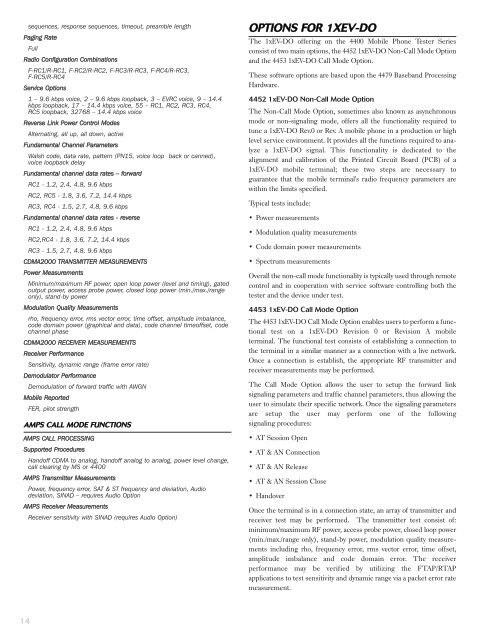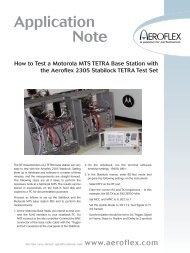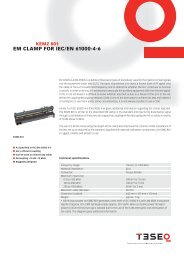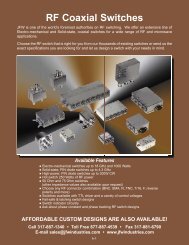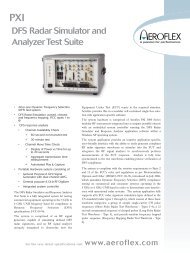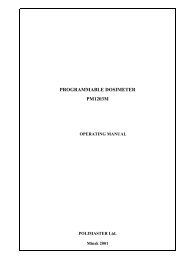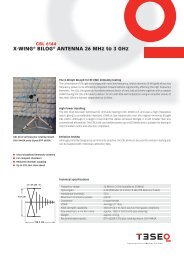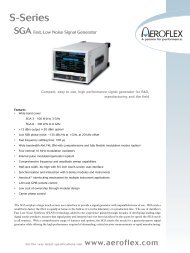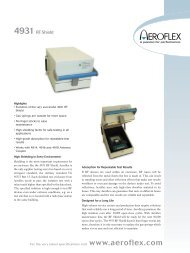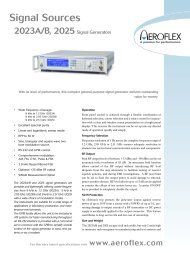Mobile Phone Tester Series - Aeroflex
Mobile Phone Tester Series - Aeroflex
Mobile Phone Tester Series - Aeroflex
You also want an ePaper? Increase the reach of your titles
YUMPU automatically turns print PDFs into web optimized ePapers that Google loves.
sequences, response sequences, timeout, preamble lengthPaging RateFullRadio Configuration CombinationsF-RC1/R-RC1, F-RC2/R-RC2, F-RC3/R-RC3, F-RC4/R-RC3,F-RC5/R-RC4Service Options1 – 9.6 kbps voice, 2 – 9.6 kbps loopback, 3 – EVRC voice, 9 – 14.4kbps loopback, 17 – 14.4 kbps voice, 55 – RC1, RC2, RC3, RC4,RC5 loopback, 32768 – 14.4 kbps voiceReverse Link Power Control ModesAlternating, all up, all down, activeFundamental Channel ParametersWalsh code, data rate, pattern (PN15, voice loop back or canned),voice loopback delayFundamental channel data rates – forwardRC1 - 1.2, 2.4, 4.8, 9.6 kbpsRC2, RC5 - 1.8, 3.6, 7.2, 14.4 kbpsRC3, RC4 - 1.5, 2.7, 4.8, 9.6 kbpsFundamental channel data rates - reverseRC1 - 1.2, 2.4, 4.8, 9.6 kbpsRC2,RC4 - 1.8, 3.6, 7.2, 14.4 kbpsRC3 - 1.5, 2.7, 4.8, 9.6 kbpsCDMA2000 TRANSMITTER MEASUREMENTSPower MeasurementsMinimum/maximum RF power, open loop power (level and timing), gatedoutput power, access probe power, closed loop power (min./max./rangeonly), stand-by powerModulation Quality Measurementsrho, frequency error, rms vector error, time offset, amplitude imbalance,code domain power (graphical and data), code channel timeoffset, codechannel phaseCDMA2000 RECEIVER MEASUREMENTSReceiver PerformanceSensitivity, dynamic range (frame error rate)Demodulator PerformanceDemodulation of forward traffic with AWGN<strong>Mobile</strong> ReportedFER, pilot strengthAMPS CALL MODE FUNCTIONSAMPS CALL PROCESSINGSupported ProceduresHandoff CDMA to analog, handoff analog to analog, power level change,call clearing by MS or 4400AMPS Transmitter MeasurementsPower, frequency error, SAT & ST frequency and deviation, Audiodeviation, SINAD – requires Audio OptionAMPS Receiver MeasurementsReceiver sensitivity with SINAD (requires Audio Option)OPTIONS FOR 1XEV-DOThe 1xEV-DO offering on the 4400 <strong>Mobile</strong> <strong>Phone</strong> <strong>Tester</strong> <strong>Series</strong>consist of two main options, the 4452 1xEV-DO Non-Call Mode Optionand the 4453 1xEV-DO Call Mode Option.These software options are based upon the 4479 Baseband ProcessingHardware.4452 1xEV-DO Non-Call Mode OptionThe Non-Call Mode Option, sometimes also known as asynchronousmode or non-signaling mode, offers all the functionality required totune a 1xEV-DO Rev.0 or Rev. A mobile phone in a production or highlevel service environment. It provides all the functions required to analyzea 1xEV-DO signal. This functionality is dedicated to thealignment and calibration of the Printed Circuit Board (PCB) of a1xEV-DO mobile terminal; these two steps are necessary toguarantee that the mobile terminal's radio frequency parameters arewithin the limits specified.Typical tests include:• Power measurements• Modulation quality measurements• Code domain power measurements• Spectrum measurementsOverall the non-call mode functionality is typically used through remotecontrol and in cooperation with service software controlling both thetester and the device under test.4453 1xEV-DO Call Mode OptionThe 4453 1xEV-DO Call Mode Option enables users to perform a functionaltest on a 1xEV-DO Revision 0 or Revision A mobileterminal. The functional test consists of establishing a connection tothe terminal in a similar manner as a connection with a live network.Once a connection is establish, the appropriate RF transmitter andreceiver measurements may be performed.The Call Mode Option allows the user to setup the forward linksignaling parameters and traffic channel parameters, thus allowing theuser to simulate their specific network. Once the signaling parametersare setup the user may perform one of the followingsignaling procedures:• AT Session Open• AT & AN Connection• AT & AN Release• AT & AN Session Close• HandoverOnce the terminal is in a connection state, an array of transmitter andreceiver test may be performed. The transmitter test consist of:minimum/maximum RF power, access probe power, closed loop power(min./max./range only), stand-by power, modulation quality measurementsincluding rho, frequency error, rms vector error, time offset,amplitude imbalance and code domain error. The receiverperformance may be verified by utilizing the FTAP/RTAPapplications to test sensitivity and dynamic range via a packet error ratemeasurement.14


